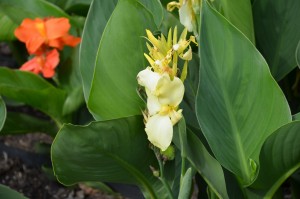Cannova® Cannas (Canna x generalis) are one of a new series of seed produced hybrid cannas. In addition to profuse flowering, they’re highly rated for their compact bushy plant habit and ability to form multiple shoots. They bloom earlier and continue nonstop through summer up to first frost.
Their bold, banana-like foliage adds a tropical look to the summer garden. New shoots emerge from large pointed buds. Large elegant lily-like flowers come in various bright colors. Cannova Cannas come in 6 flower choices: red, rose, yellow, scarlet with bronze foliage, lemon, and mango.
Cannas are indigenous to the tropical and subtropical regions of the world, but thrive in cool temperate zones with warm summers. Cannas grow from rhizomatous root systems that are sensitive to sub-zero soil temperatures. In colder regions, cut off above ground shoots, dig up, and store them inside around 40 °F.
Cannova cannas are produced virus-free. In recent years many vegetative canna varieties have become infected with a virus disease which stunts growth, distorts and discolors foliage, and reduces flowering. Purchase only cannas that are guaranteed virus-free. Beware that the virus can be spread from already infected cannas via aphids to healthy ones.
Cannova Cannas usually arrive at garden centers already budded up or in bloom. Carryover plants re-bloom in late May to early June and thrive up to first frost. Deadheading spent flowers in summer will promote re-blooming.
For continuous flowering, cannas need at least 6 – 8 hours of direct sunlight during the growing season. Feed with 10-10-10 or equivalent fertilizer or water soluble fertilizers such as Miracle-Gro™, Nature Source™, or Schultz™. Plant in a compost-rich potting soil or garden bed and keep watered as needed. Optimum soil/media pH range is between 5.5- 6.2.
While disease and pest problems are few, keep an eye out for thrips, red spider mites, and pythium, rhizoctonia, and botrytis diseases.
Plant cannas in containers and grow on a deck or patio. Submerse container(s) in shallow ponds or water gardens. Site in a garden bed with other annuals and perennials.



 Posted in
Posted in 
